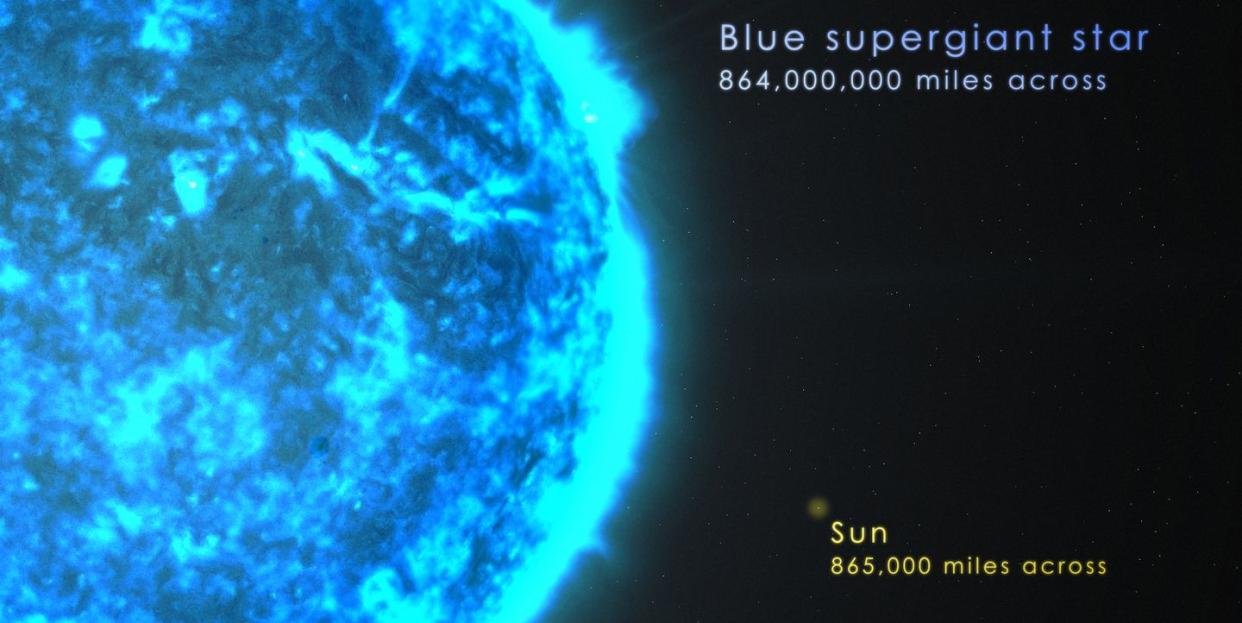Astronomers Finally Able to See Beneath Surface of Mysterious Blue Supergiants

For the first time ever, scientists have been able to "see" the magnetic waves originating under the surface of a blue supergiant, one of the universe's most elusive stars.
Some stars, like Earth's sun, are stable. Other stars can be far more erratic. Blue supernovas make a big splash in their region of space because of their tremendous size-they have masses approximately 20 times that of Earth's sun, and their total energy emitted, their luminosity, is 117,000 times greater.
Their surface temperatures range between 20,000 and 50,000 degrees Celsius, and their brightness means that many of the stars seen in the night sky are, in fact, blue supergiants.
Some scientists have nicknamed blue supergiants the "rock-and-roll" stars, for their tendency to live fast and die young. In exchange for their tremendous size and energy, blue supernovas have short lifespans. They only live around 10 million years, which sounds like a long time ... until you realize the sun can live to be 10 billion.
While they're alive, blue supergiants produce a tremendous amount of energy within themselves. This comes to the surface as luminosity and as stellar wind, which can blow off the surface at an astonishing 1,700 kilometers per second, or approximately 3,802,792 miles per hour.
Previously, we didn't know what actually happens inside the stars that allows that tremendous energy to be released. Now, scientists have found gravity waves coming through their surface, allowing for a far richer understanding of the stars.
“The discovery of waves in so many blue supergiant stars was a eureka moment,” says postdoctoral researcher Dominic Bowman of the Belgian university KU Leuven, who is the corresponding author of this study, in a press statement.
"The flicker in these stars had been there all along,” Bowman says. “We only had to wait for modern space telescopes to be able to observe them. It is as if the rock-and-roll stars had been performing the whole time, but only now NASA space missions were able to open the doors of their concert hall. From the frequencies of the waves at the surface, we can derive the physics and chemistry of their deep interior, including the stellar core. These frequencies probe how efficiently metal is produced and how it moves around in the factory."
The KU Leuven team, working with an international team of scientists, relied on data gleaned from NASA's Kepler/K2 and TESS satellites. Neither of these spacecrafts were intended to study stars; they were both built with a focus on exoplanets, or planets beyond the solar system.
Finding exoplanets, however, means finding stars. Both the Kepler/K2 mission and TESS look for exoplanets by searching the skies for transits, when the exoplanets would block part of the light from their host stars. Mapping out blue supergiants was just part of the job for both of the missions, and their data is proving invaluable to scientists even outside their intended work.
"We are now entering a golden age of asteroseismology of hot massive stars thanks to modern space telescopes," Bowman says.
The discovery of these waves will allow scientists "to map the evolution of hot massive stars towards the ends of their lives," according to the team's abstract.
"Before the NASA Kepler/K2 and TESS space telescopes, few blue supergiants that vary in brightness were known," says Bowman. "Until now, we had not seen these waves causing shimmering and twinkling on the surface of blue supergiants. You need to be able to look at the brightness of an individual star for long enough with a very sensitive detector before you can map out how it changes over time."
Source: KU Leuven
('You Might Also Like',)

